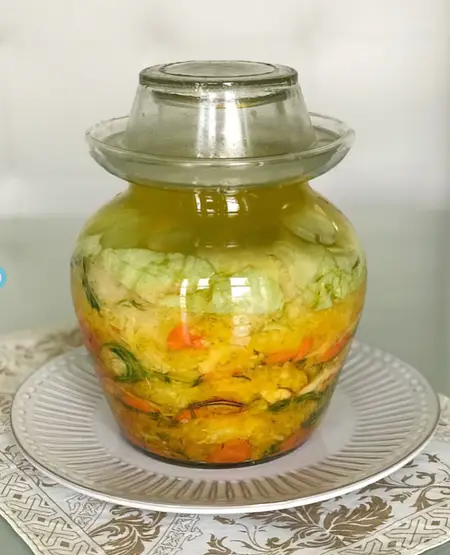
How to Make Sauerkraut with Probiotics DIY
What is fermentation?
Fermentation it’s an ancient method of food preservation using wild, naturally occurring lacto-bacteria to preserve vegetables
and has been practiced by almost every culture throughout time. Using a probiotic to obtain a consistent strain of friendly bacteria is the modern and safer way to produce sauerkraut. When you ferment without probiotics, you are using air-borne bacteria that will populate your fermentation without you really knowing what kind of strain has reproduced in your sauerkraut. If bad airborne bacteria populate your fermentation, the consumer might get sick.
When using probiotics, you are adding several strains of bacteria, producing a “controlled fermentation,”
which assures the reproduction of beneficial bacteria that are truly favorable to your health. The beneficial bacteria create a lactic acid environment that aids in avoiding harmful bacteria and fungal growth by providing an acidic environment where dangerous bacteria and fungi cannot develop. This is exactly why fermentation is used for food preservation, increasing the shelf life of the vegetables, almost indefinitely.
The word lacto comes from the word Lactobacillus, a strain of genius bacteria that is extremely beneficial to our digestive system.
This controlled fermentation method will offset the reproduction of harmful bacteria. I use a multi-strain, vegan, non-GMO, probiotic that supports beneficial bacteria reproduction. Sauerkraut is vital for your health; eat it every day, with every meal.
Tools
There are many different devices for pickling and fermenting. My favorite ones are the airlock system and water seal locks, which are traditional Japanese or Chinese water seal fermenting crocks. These jars come in ceramic or glass. I prefer to use glass because I like to watch the fermentation process. For the picture that you see in this blog, I used a traditional Chinese glass water seal-pickling jar.
Check out here my Fermentation Tools Amazon Shopping list.

White Sauerkraut Recipe
Makes: 8 cups
Ingredients:
2 heads white cabbage, large
2 tspsalt
10 tbsp.dulse flakes
¼ tsp. probiotics (I sell probiotics at my studio, and I will be selling them in my virtual shop soon, too.)
3 tbsp. caraway seeds
cup sliced carrots
• ½ cup sliced radishes
• ½ cup sliced mini peppers
Equipment:
Half-gallon jars with airlock lids, or a traditional Chinese fermenting crock. (see photo)
Food processor with slicing blade (set on thinnest setting), or mandolin.
Flat-surfaced tool like a rolling pin.
Four or six glass weights.
Method of Preparation:
Shred the cabbage in a food processor or on a mandolin for ultra-thin sauerkraut.
Massage the shredded cabbage by hand with salt, until the action releases the water from the cabbage. This is an important step; you’ll know the cabbage is ready to transfer to the pickling jar when you press it down with your hand and water covers it.
Fold in the probiotic.
Create layers. Start the first layer at the bottom of the jar with the dulse flakes, caraway seeds, carrots, radishes and mini peppers. For the second layer, add the massaged cabbage. Pack it tightly, and ensure that every time you press down water covers it. Repeat the process and create a layer just like the first one, followed by another layer of massaged cabbage. Keep on layering until you finish with all your ingredients, but make sure you top off the jar with the cabbage. If you press on the layers and see that you don’t have enough water to cover your last layer by at least ¼ inch of water, you can add spring water until the cabbage is covered by at least ¼ inch of water.
Add the glass weights on top of the last layer to help the cabbage stay submerged in the water.
If you are using a traditional Chinese or Japanese water seal crock, make sure to add water to the external lip of the glass rim in order to trigger the sealed water locks. The water seal becomes a filter letting the fermentation breathe and reproduce, thereby minimizing the chance of air-borne bacteria landing directly in your sauerkraut. Watch the jars, throughout the days to make sure the water is not evaporating from the external lip of the rim. You might see that the water moves from outside the rim to inside the rim; this is a normal process. If the water is evaporating, add more water as needed throughout the days. If you decide to use the air-lock system, read the instructions that come with the system in order to properly seal it.
Let the sauerkraut (in sealed jars) sit out at room temperature for 12 days. Keep a tray underneath the jar to avoid spills and leaks.
After 12 days, you can open up the jar and take off the weights. If you are using an air-lock system just replace the fermenting lid with a plain lid and refrigerate. If you are using a traditional Chinese or Japanese water seal system, pour out the water from the lip of the rim and transfer the contents to smaller jars with lids and refrigerate. Your sauerkraut is done! Refrigerate and enjoy as a side dish with salad, sandwiches or in wraps.
From my upcoming book Love, Peace & Vegetables, which focuses on how to live a love-centered, holistic lifestyle with joy, ease and wisdom!


